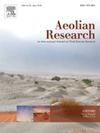10米风在伊朗西北部山区沙尘事件模拟中的验证(2017年10月28-31日)
IF 3.4
3区 地球科学
Q2 GEOGRAPHY, PHYSICAL
引用次数: 0
摘要
本研究评估了WRF-Chem模式在模拟伊朗西北部近地面风方面的性能,该地区由于其高山和多种结构而容易发生沙尘事件。该研究使用了2017年10月28日至31日的数据,首先通过能见度和卫星图像检查了尘埃状况。然后根据观测资料评估了该模式在MYJ和YSU边界层方案的三个嵌套中模拟10米风速和风向的精度。结果表明:10月29日沙尘的主要来源是伊拉克和沙特阿拉伯北部的沙漠地区,沙尘团向伊朗西北部输送。研究发现,沙尘在该区域内由西南向东北移动的强度和持续时间最高。WRF-Chem模式在模拟风速和风向方面表现出较好的效果,其中MYJ方案在伊朗西部北部沙尘条件下的模拟效果优于YSU方案。研究还强调,虽然提高分辨率可以提高站高值,但仅提高分辨率并不能显著改善模型结果。在这种情况下,利用双向方差分析发现,边界层影响不同站点10米风速估计的精度。这些发现强调了考虑边界层方案和山地特征对提高山区风型模拟模式精度的重要性。WRF-Chem模式充分模拟了该地区的风向,特别是当一个站点的主导风向落在特定的地理主导扇区内时。本文章由计算机程序翻译,如有差异,请以英文原文为准。
Validation of a 10-meter wind in simulating a dust event in northwestern Iran mountains (October 28–31, 2017)
This study evaluates the performance of the WRF-Chem model in simulating near-surface winds in Northwest Iran, a region prone to dust events due to its high mountains and diverse structures. Using data from October 28 to 31, 2017, the study first examines dust conditions through visibility and satellite images. The model’s accuracy in simulating 10-meter wind speed and direction in three nested with the MYJ and YSU boundary layer schemes is then assessed against observational data. Results indicate that the primary source of dust on October 29 was desert areas in Iraq and northern Saudi Arabia, with the dust mass transported to Northwest Iran. The study observes the highest intensity and duration of the dust moving from southwest to northeast within the area. The WRF-Chem model shows good performance in simulating wind speed and direction, with the MYJ scheme performing better than YSU in a selected dust case in northern west of Iran. The study also highlights that while improving resolution enhances station altitude values, it alone does not significantly improve model results. In this case, the utilization of a two-way ANOVA revealed that the boundary layer affects the accuracy of 10-meter wind speed estimation at different stations. These findings underscore the importance of considering boundary layer schemes and mountain characteristics in improving the accuracy of models simulating wind patterns in mountainous regions. The WRF-Chem model adequately simulates wind direction in this region, especially when the dominant wind direction at a station falls within a specific geographical dominant sector.
求助全文
通过发布文献求助,成功后即可免费获取论文全文。
去求助
来源期刊

Aeolian Research
GEOGRAPHY, PHYSICAL-
CiteScore
7.10
自引率
6.10%
发文量
43
审稿时长
>12 weeks
期刊介绍:
The scope of Aeolian Research includes the following topics:
• Fundamental Aeolian processes, including sand and dust entrainment, transport and deposition of sediment
• Modeling and field studies of Aeolian processes
• Instrumentation/measurement in the field and lab
• Practical applications including environmental impacts and erosion control
• Aeolian landforms, geomorphology and paleoenvironments
• Dust-atmosphere/cloud interactions.
 求助内容:
求助内容: 应助结果提醒方式:
应助结果提醒方式:


